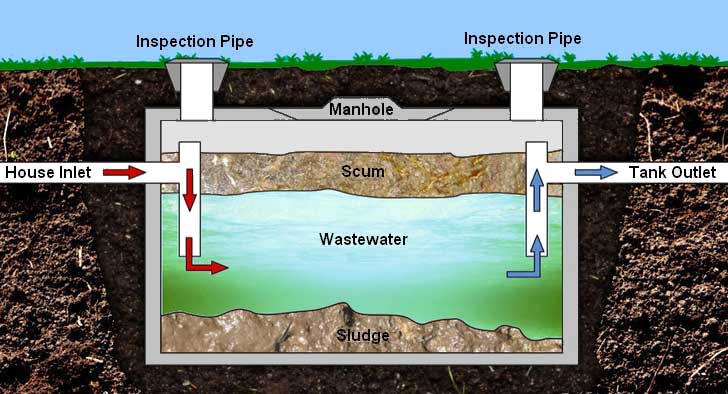Foreword: The invention of the septic tank is credited to a Frenchman named Jean Louis Mouras around 1860. He was determined to invent a waste disposal system that prevented you from having to go outside. After ten years, he dug up his tank and discovered it was mostly liquid waste. After this discovery he began to perfect his design, and in 1881 he was granted a patent, and this septic tank made its way to the United States in 1883.
What is a Septic Tank?
A septic tank is an underground container that is part of a waste disposal system for homes that are not connected to a sewer system. They work in conjunction with a drain field and a series of pipes to remove waste from a home.
Many homes around the country that do not have access to a city's sewer system use a septic system to remove wastewater. After the initial cost and installation, maintenance costs for septic systems are very low if installed properly. The highest quality and most expensive tanks are made of concrete, but they can also be made of fiberglass and polyethylene.
How does a septic tank work?
A septic tank is a watertight container that collects all the water from a house. When waste collects in a septic tank, it is separated into three layers: scum, wastewater and sludge.
Foam is the top layer of waste in a tank. It consists of oils and fats that float to the top of the water when allowed to sit. Foam is a byproduct of cooking grease, soap and other greases that can come from cleaning products or hand washing.
Effluent is the middle waste layer consisting of water left over after the scum has floated to the top and the sludge has settled to the bottom of the tank. The wastewater is pumped through the tank outlet to the drain field, where it is dispersed into the soil.
Sludge is the bottom layer of waste in a septic tank. It consists of solid waste that sinks to the bottom of the tank as it separates from the water. Sludge is also made up of byproducts from other wastes that decompose in the tank.
 Septic Tank System
Septic Tank System
A septic tank relies on bacteria to break down solid waste that settles to the bottom. Once the solids have broken down into a liquid, they are pumped to the drain field. The drain field works in combination with the septic tank. Waste containing sufficient liquid to be pumped from the tank is discharged into the soil via the drain field.
Problems can arise if a tank's sludge layer becomes too high. This can clog the exhaust pipe and prevent water from flowing to the drain field. When this happens, puddles form in your yard as the tank overflows. When you empty your tank, a bacterial additive may be added to increase the efficiency of the bacteria breaking down the sludge into liquid.
Septic tanks are usually made of concrete, fiberglass or polyethylene. These materials are ideal because they are not susceptible to cracks underground. If a septic tank bursts, waste will leak out and form a puddle on the surface above the tank. A septic tank holds wastewater long enough for solids and oils to be separated.
How does a drainage field work?
The septic tank is connected to a drain field, also called a leach field, via a pipe buried underground. Drain fields are usually located in a flat, large open space in the backyard of a home and can have several ditches ranging from 18 to 36 inches deep, one to three feet wide and about 100 feet long.
A drainage field removes and manages the waste that flows from the wastewater from your septic tank and disperses it through pipes in the soil. The treated wastewater (liquid) from the septic tank is deposited in the drainage field where it passes through “septic stone” where gravel and soil filter and purify it. When water passes through the drain field, the soil naturally removes bacteria, viruses and other contaminants in the waste.

Image.. www.hornsby.nsw.gov.au
The lack of a drain field or one that does not work efficiently would mean septic tanks overflowing, creating a horrible stench in your garden.